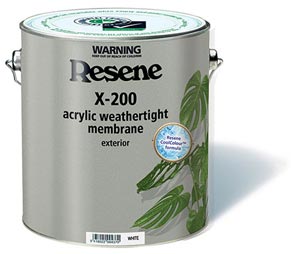Resene DIY project #2
How to paint like a professional - training videos and project sheets
Applying Resene X-200 membrane to concrete or plaster for a weathertight finish
Resene X-200 is an acrylic weathertight membrane incorporating the most recent advances in polymer and paint technology. Shows significant advances in the areas of film build, adhesion, penetration, application and durability.
| View video |

Treat moss and mould using Resene Moss & Mould Killer (see Data Sheet D80). Concrete, plaster and other cementitious surfaces, even if previously painted, will support moss and mould growth and this needs to be killed and removed before painting, otherwise it will grow back but this time underneath the new paintwork.
For repaints or weathered surfaces, wash and scrub using Resene Paint Prep and Housewash (see Data Sheet D812) to de-chalk old paint films and remove any contaminants including mould residue. Wash new concrete and plaster with Resene Paint Prep and Housewash to remove loose material and contaminants including form oils. Form oils are used on new concrete to prevent it from sticking to the timber or steel that is used to shape it as it dries. A solvent such as Resene Emulsfiable Solvent Cleaner (see Data Sheet D804) may be required to remove some form oils.
For repaints or weathered surfaces, seal and prime cracks and bare areas with Resene Sureseal (see Data Sheet D42) or Resene Concrete Primer (see Data Sheet D405) if all salts have been washed out of crevices etc. Seal new plaster and concrete with Resene Limelock (see Data Sheet D809) to prevent lime burn of the paint, promote surface curing and reduce hairline cracks etc.
Stir the paint thoroughly using a flat bladed stirrer and decant from larger pails into smaller more manageable containers, such as the Resene Paint pot.
The key to a top quality finish is to use a 25mm PAL lambswool roller (available in 180mm to 230mm sizes, an alternative for small areas is the PAL No.3 roller sleeve), a short extension handle and a good quality brush. We recommend the PAL Legend brush – depending on how difficult cutting-in around edges etc is likely to be a small 35mm to 50mm brush is ideal, the larger 63mm and 75mm brushes are usually used by more experienced painters or if cutting-in is straightforward. 6. If hot and dry or very windy add Resene Hot Weather Additive to improve Resene X-200’s flow and prevent it drying too quickly. 7. Please take the time to carefully read through the instructions on the label. More information including Data Sheets and Safety Data Sheet/s (SDS) can be found on the Resene website.
When painting exterior plaster and concrete walls it is important to plan your approach. Start at the top of the wall and work down and across it. Start by brushing Resene X-200 into any cracks or voids. Brush across rather than down the crack. Any cracks larger than 1mm will need to be filled with Resene Brushable Crack Filler (see Data Sheet D811) or a gunnable sealant (ideally a paintable silicone). Allow to dry.
Now cut-in around the edges and any areas where the roller will not reach, for example around downpipes etc. Use masking tape on windows etc if you are not confident or a very sharp paint edge is needed.
Add about 1 to 1 1/2 litres of Resene X-200 to the roller tray and carefully load the roller up with Resene X-200. This will usually take two to three minutes. Lay the roller against the wall and roll in an upwards direction – typically the roller will skid rather than rotate at first until it gains traction. Aim to complete 1/2 to 3/4 of a square metre with each roller load and once done lay-off as you progress along the wall.
It is important to force enough Resene X-200 into any cracks to weatherproof the wall. This will not happen if there is insufficient pressure applied, the angle of the extension handle is too acute or it is held too far down its length.
Once you have completed a section of the wall lay-off from the top to the bottom.
Once dry, usually after three to four hours apply a second coat. A third coat is not usually needed except on unpainted concrete blocks due to their porosity and the need to get sufficient Resene X-200 into the blocks voids.
Try not to paint too late in the day to avoid dew settling and marking the paint.
Resene CoolColour™ technology is available in many exterior Resene finishes, including Resene X-200 in a wide range of colours. Formulated with special pigment technology, a Resene CoolColour will reflect more heat than a standard colour, reducing the stress on the coating, substrate and building, keeping them cooler.
› Download this project sheet as a PDF
Training Videos and Project Sheets
Learn how to prepare surfaces and apply paint to get the best from your paint finish with these handy videos and project sheets.